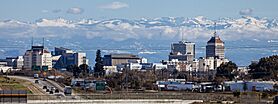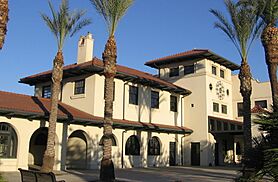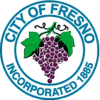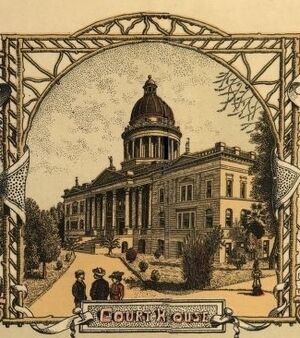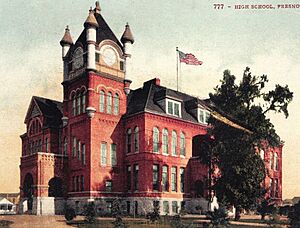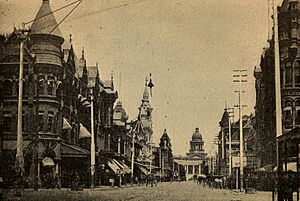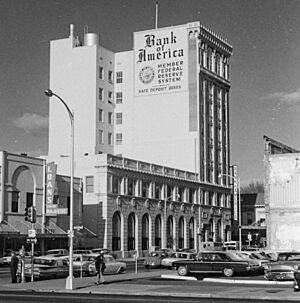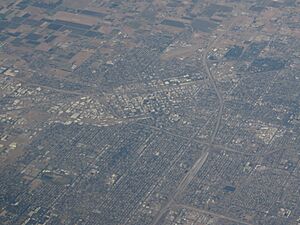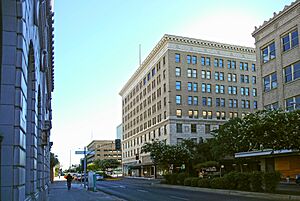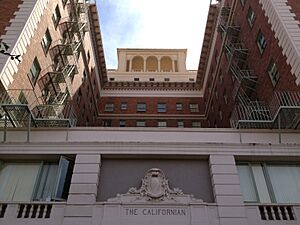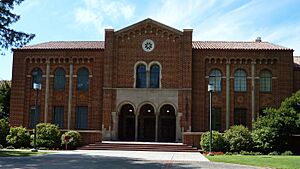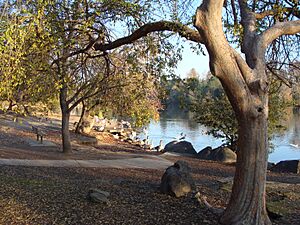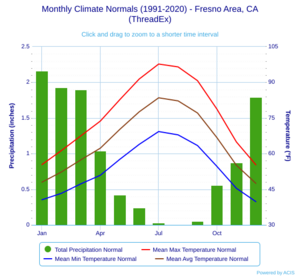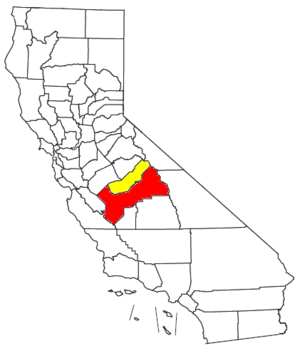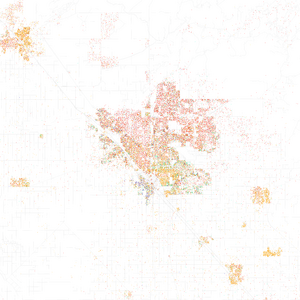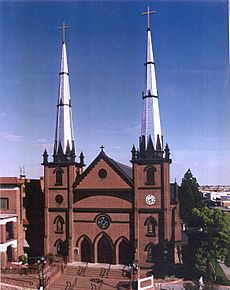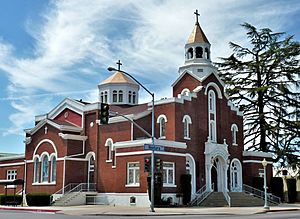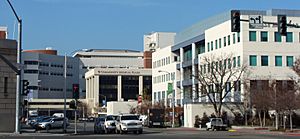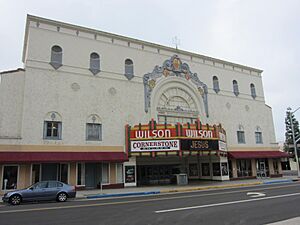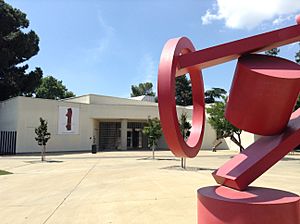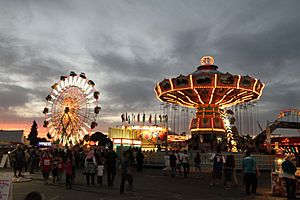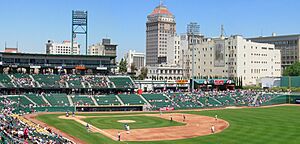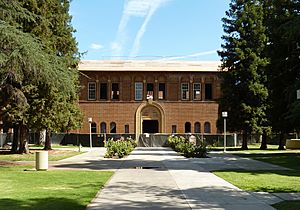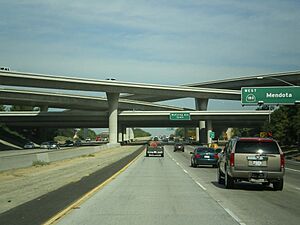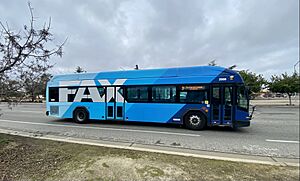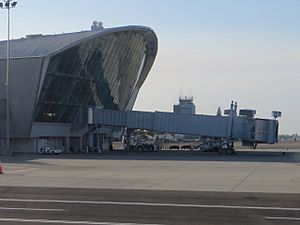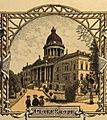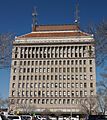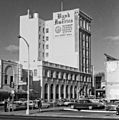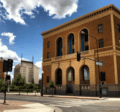Fresno, California facts for kids
Quick facts for kids
Fresno
|
|||
|---|---|---|---|
|
|
|||
|
|||
| Country | United States | ||
| State | California | ||
| County | Fresno | ||
| Region | San Joaquin Valley | ||
| Railway station | May 1872 | ||
| Incorporated | October 21, 1885 | ||
| Named for | Spanish for "ash tree" | ||
| Government | |||
| • Type | Strong Mayor | ||
| Area | |||
| • City | 116.00 sq mi (300.43 km2) | ||
| • Land | 114.79 sq mi (297.30 km2) | ||
| • Water | 1.21 sq mi (3.13 km2) 1.04% | ||
| Elevation | 308 ft (94 m) | ||
| Population
(2020)
|
|||
| • City | 542,107 | ||
| • Rank | 89th in North America 34th in the United States 5th in California |
||
| • Density | 4,722.60/sq mi (1,823.43/km2) | ||
| • Urban | 717,589 (US: 61st) | ||
| • Urban density | 4,510.0/sq mi (1,741.3/km2) | ||
| • Metro | 1,164,909 (49th) | ||
| Demonym(s) | Fresnan | ||
| Time zone | UTC−08:00 (Pacific) | ||
| • Summer (DST) | UTC−07:00 (PDT) | ||
| ZIP Codes |
93650, 93701–93712, 93714–93718, 93720–93730, 93737, 93740, 93741, 93744, 93745, 93747, 93750, 93755, 93760, 93761, 93764, 93765, 93771–93779, 93786, 93790–93794, 93844, 93888
|
||
| Area code | 559 | ||
| FIPS code | 06-27000 | ||
| GNIS feature IDs | 277606, 2410546 | ||
Fresno is a large city in the San Joaquin Valley of California, United States. It's the main city of Fresno County and the biggest city in the wider Central Valley area. Fresno covers about 115 square miles (300 km²) and had a population of 542,107 people in 2020. This makes it the fifth-largest city in California and the 34th-largest in the United States.
The city got its name from the many ash trees (fresno in Spanish) that grew along the San Joaquin River. Fresno started in 1872 as a railway station for the Central Pacific Railroad and became an official city in 1885. Today, it's an important economic center for Fresno County and the San Joaquin Valley, especially known for its huge farms. Fresno is located near the middle of California. It's about 220 miles (354 km) north of Los Angeles, 170 miles (274 km) south of Sacramento, and 185 miles (298 km) southeast of San Francisco. Famous national parks like Yosemite National Park, Kings Canyon National Park, and Sequoia National Park are also close by.
Contents
History of Fresno
The first people to live in the San Joaquin Valley were the Yokuts people and Miwok people. They traded goods with other Native American tribes in California, including those living near the coast.
The first European to explore the San Joaquin Valley was Pedro Fages in 1772. Fresno County was created in 1856, and it was named after the many ash trees (fresno in Spanish) found along the San Joaquin River.
In 1867, a big flood on the San Joaquin River damaged the town of Millerton. Some people rebuilt, while others moved. That same winter, flooding also destroyed Scottsburg on the nearby Kings River. When it was rebuilt on higher ground, Scottsburg was renamed Centerville.
In 1870, Moses Church created an irrigation system to bring water to farms. He formed the Fresno Canal and Irrigation Company. In 1872, the Central Pacific Railroad built a station near a large wheat farm. Soon, a store opened near the station, and this small settlement grew into the town of Fresno Station, later just called Fresno. Many people from Millerton moved to Fresno because of the railroad and to avoid floods. Fresno officially became a city in 1885.
Two years after the railway station was built, people in the county voted to move the county seat (the main government town) from Millerton to Fresno. When the Friant Dam was finished in 1944, the area where Millerton once stood was covered by Millerton Lake. If there are very dry years and the lake shrinks, you can sometimes still see the old town's ruins.
In the 1800s, many American towns were built with wood, and there weren't good ways to fight fires. Fresno had big fires in 1882 and 1883 that destroyed parts of the city.
In 1910, Fresno High School became the first high school in California to offer college-level classes. This helped local students who wanted to go to college but couldn't move far away. This program eventually grew into Fresno City College, which is the oldest community college in California. Later, Fresno State Teachers College became California State University, Fresno, offering many different subjects.
Fresno grew quickly in the 20th century. In 1960, it had 134,000 people. By 1990, it had grown to 354,000, and in 2000, it reached 428,000 people.
The Fresno Sanitary Landfill was the first modern landfill in the United States. It used new ways to get rid of trash, like burying it and covering it with dirt every day. It opened in 1937 and closed in 1987.
Before World War II, Fresno had many neighborhoods where different groups of people lived, like Little Armenia, German Town, Little Italy, and Chinatown. During World War II, many Japanese Americans from the Fresno area were moved to special camps, including the Pinedale Assembly Center and the Fresno Fairgrounds.
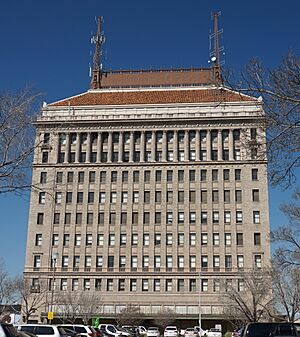
After World War II, many farms and orchards were replaced by new buildings and neighborhoods, especially along Blackstone Avenue.
Fresno was also important in the history of credit cards. In 1958, Bank of America first launched its new "BankAmericard" in Fresno. This card later became Visa, the world's first successful credit card that you could use at many stores and pay back over time. Fresno was chosen because it was far away from bigger cities, so if the idea didn't work, it wouldn't hurt the bank's image too much.
In the 1960s, many old buildings in Fresno, like the old Fresno County Courthouse, were torn down. This happened because city planners wanted more space for cars and parking lots.
The dance style known as popping started in Fresno in the 1970s.
In the 1990s, some politicians in Fresno and Clovis were caught taking bribes to change farmland into areas for new houses. This was part of an investigation called "Operation Rezone."
In the early 2000s, two major event places were built in Fresno: Chukchansi Park (2002) and Save Mart Center (2003).
Geography of Fresno
Fresno covers about 116 square miles (300 km²). Most of this area is land (about 114.79 square miles or 297.30 km²), and a small part is water (about 1.21 square miles or 3.13 km²).
Fresno is located almost exactly in the middle of California. This makes it easy to reach many fun places and big cities in the state. It's only about 60 miles (97 km) south of Yosemite National Park, making it the closest major city to the park. Also nearby are Sierra National Forest (40 miles or 64 km), Kings Canyon National Park (60 miles or 97 km), and Sequoia National Park (75 miles or 121 km). The city is also close to several lakes in the Sierra Nevada mountains, like Bass Lake, Shaver Lake, and Huntington Lake. You can also drive to the coast, like Monterey and Big Sur, in about two and a half hours.
Fresno is a major stopping point for visitors going to Yosemite National Park from Los Angeles, because it's where Highways 41 and 99 meet. Highway 41 leads to Yosemite, and Highway 99 goes through many cities in the San Joaquin Valley.
Fresno has three large public parks. Woodward Park in North Fresno has a beautiful Shinzen Japanese Garden, picnic areas, and miles of trails. It's next to the San Joaquin River Parkway. Roeding Park, near Downtown Fresno, is home to the Fresno Chaffee Zoo and Rotary Storyland and Playland. Kearney Park is the biggest park in the Fresno area. It has the historic Kearney Mansion and hosts the annual Civil War Revisited, which is the largest Civil War reenactment on the West Coast.
In 2023, a study found that Fresno had one of the smallest park systems among the 100 biggest U.S. cities. Only 5% of the city's land is used for parks.
Fresno Neighborhoods
Downtown Fresno
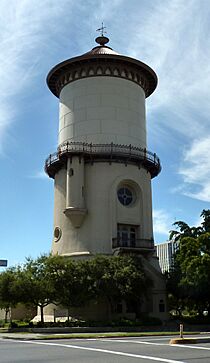
The Central Pacific Railroad built a small train station in 1872. Later, the Southern Pacific Railroad built a new, beautiful brick station there in 1889. This station is one of Fresno's oldest buildings still standing.
From the 1880s until World War II, Downtown Fresno was a busy place with electric streetcars and many grand buildings. Some of these included the Old Fresno Water Tower, the Bank of Italy Building, and the San Joaquin Light and Power Building.
Fulton Street was the main shopping and business area in Downtown Fresno. In 1964, it was turned into one of the first pedestrian malls in the country, called the Fulton Mall. This area has many historic buildings and famous public art pieces, including a bronze statue by Pierre-Auguste Renoir. In 2017, Fulton Mall was reopened to traffic and became Fulton Street again, but it still has wide sidewalks and restored art.
Tower District
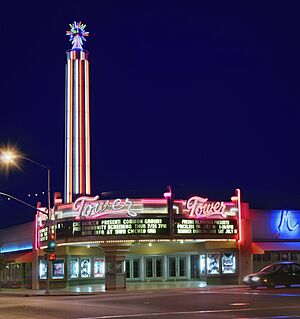
The historic Tower Theatre, built in 1939, is the heart of the Tower District. This neighborhood is just north of downtown Fresno. It started as a residential area, but small shops and services began to open after World War II. The area still has many local businesses today. The Tower District grew partly because of its closeness to the original Fresno Normal School, which later became Fresno City College.
After a period of decline, the neighborhood became popular again when the Tower Theatre reopened in the late 1970s. Roger Rocka's Dinner Theater also opened nearby in 1978. Famous Broadway star Audra McDonald performed there when she was in high school.
The Tower District is a lively place for community events like Mardi Gras, the Gay Pride Parade, car shows, and a Farmers' market. It has many restaurants, live theaters, nightclubs, and unique shops. The Tower District is known as the center of Fresno's LGBT and hipster communities.
The area is also famous for its beautiful early 20th-century homes. Many of these homes have been restored and show different styles like California Bungalow, American Craftsman, and Spanish Colonial Revival Style architecture.
Woodward Park
Woodward Park is in the northeastern part of Fresno. It was created by Ralph Woodward, who left money in 1968 to build a large park and bird sanctuary. The park is on the south bank of the San Joaquin River and covers about 300 acres (1.2 km²).
Woodward Park has many features, including an outdoor theater that can hold up to 2,500 people, a real Japanese Garden, a fenced dog park, and a bike park. There are also playgrounds, a lake, ponds, picnic areas, and five miles (8 km) of trails. These trails are part of the Lewis S. Eaton Trail, which will eventually be 22 miles (35 km) long. The park's theater was updated in 2010 and has hosted many concerts. Woodward Park also hosts the annual California Interscholastic Federation State Championship cross country meet. The Woodward Shakespeare Festival performs plays in the park every year.
Fig Garden
Old Fig Garden is a community in western Fresno that is now surrounded by the city. It was started in 1947 by the Fig Garden Men's club. In 1979, it became the Fig Garden Home Owners Association. Fig Garden is special because it has very few sidewalks and is lined with many large trees. The homes are well-kept because of strict rules from the homeowners association. Residents pay a special tax for almost round-the-clock sheriff service.
The district hosts the Fig Garden Christmas Tree Lane, a famous holiday event. There is also an upscale swim and racquet club. In the northern part of the area, you'll find Fig Garden Village, a shopping center with many fancy stores.
Climate in Fresno
Fresno has a semi-arid climate, which means it has cool, mild winters and long, hot, dry summers. December and January are the coldest months, with average temperatures around 47-48°F (8-9°C). In the mornings, temperatures can drop to freezing or below. July is the warmest month, averaging about 83.5°F (28.6°C). It often gets above 100°F (38°C) in the summer, and it's usually above 90°F (32°C) for many days.
Summers are very sunny, but in winter, especially December, there can be a lot of tule fog, which reduces sunshine. On average, Fresno gets about 11 inches (280 mm) of rain each year. Snow is very rare.
The highest temperature ever recorded in Fresno was 115°F (46°C) on July 8, 1905. The lowest was 17°F (-8°C) on January 6, 1913.
People of Fresno
Fresno is the main city of the Fresno-Madera area, which includes Fresno County and Madera County. This larger area had a total population of 922,516 people in 2000.
Fresno is home to many different ethnic groups, including large Armenian and Hmong communities. In 1920, Armenians made up 9% of Fresno's population. Old Armenian Town was the old Armenian neighborhood. The Hmong community in Fresno is one of the largest in the U.S., with over 24,000 people of Hmong descent, making up about 5% of the city's population.
Population in 2010
In 2010, Fresno had a population of 494,665 people. About 49.6% of the people were White, 8.3% were African American, 1.7% were Native American, and 12.6% were Asian. A large part of the Asian population included Hmong, Indian, Filipino, and Laotian people.
About 46.9% of the people in Fresno were Hispanic or Latino. Most of them were of Mexican descent. The number of non-Hispanic White people in Fresno decreased from 72.6% in 1970 to 30.0% in 2010.
Most people (98.2%) lived in homes, while a small number lived in group housing or institutions. There were 158,349 households in Fresno. About 43.3% of these households had children under 18. The average household had 3.07 people.
The population's age breakdown showed that 30.1% were under 18, 12.7% were aged 18 to 24, 27.3% were 25 to 44, 20.6% were 45 to 64, and 9.3% were 65 or older. The average age was 29.3 years.
Population in 2000
In 2000, Fresno had 427,652 people. The population density was about 4,098 people per square mile (1,582 per km²). The racial makeup was about 50.2% White, 8.4% Black or African American, 1.6% Native American, and 11.2% Asian (with many Hmong people). About 39.9% of the population was Hispanic or Latino.
There were 140,079 households. About 40.4% of them had children under 18. The average household size was 2.99 people, and the average family size was 3.57.
The median income for a household in Fresno was $32,236, and for a family it was $35,892. The average income per person was $15,010. About 26.2% of the population, including 36.5% of those under 18, lived below the poverty line.
Economy of Fresno
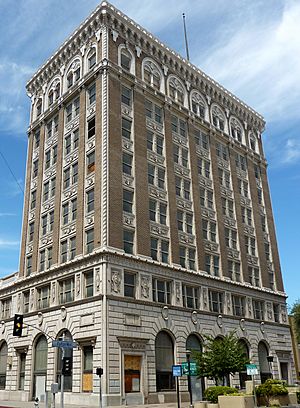
Fresno is the main economic center for the San Joaquin Valley and the larger Central Valley region. The areas around Fresno are mostly used for large-scale farming.
In 1958, Fresno was chosen by Bank of America to be the first place to launch the BankAmericard credit card. This card was later renamed Visa.
Some companies based in Fresno include Pelco, Valley Yellow Pages, and Saladino's.
The top employers in Fresno include:
- Fresno Unified School District (13,669 employees)
- Community Medical Centers (9,750 employees)
- County of Fresno (8,980 employees)
- Amazon (6,500 employees)
- Clovis Unified School District (6,400 employees)
- California State University, Fresno (5,233 employees)
- City of Fresno (5,015 employees)
- State Center Community College District (4,367 employees)
- Internal Revenue Service (4,230 employees)
- Saint Agnes Medical Center (2,900 employees)
Arts and Culture in Fresno

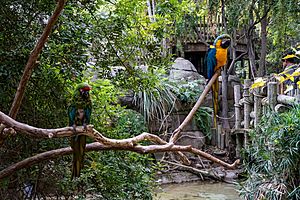
Fresno has a lively arts and culture scene.
Performing Arts and Music
- Artists' Repertory Theatre
- Children's Musical Theatreworks
- Fresno Philharmonic
- Roger Rocka's Dinner Theater & 2nd Space Theatre (Good Company Players)
- Woodward Shakespeare Festival
- Youth Orchestras of Fresno
Theaters
- Azteca Theater
- Crest Theatre
- Liberty Theatre
- Tower Theatre – Tower Theatre for the Performing Arts
- Warnors Theatre – Warnor's Center for the Performing Arts
- Wilson Theatre – currently Cornerstone Church
- Veteran's Memorial Auditorium
- Paul Shaghoian Memorial Concert Hall - Clovis North High School
Museums in Fresno
- African-American Museum of the San Joaquin Valley
- Arte Américas
- Armenian Museum of Fresno
- Discovery Center
- William Saroyan House Museum
- Forestiere Underground Gardens
- Fresno Art Museum
- Kearney Mansion Museum
- Legion of Valor Museum
- Meux Home Museum
- Old Fresno Water Tower Tourist Center
- Fresno Chaffee Zoo
- Sierra Endangered Cat Haven (Fresno County)
Events in Fresno
- Ani-Me Con (every spring) Fresno's only anime convention.
- Armenian Grape Blessing (August)
- ArtHop (first Thursday of every month)
- The Big Fresno Fair, a 12-day event in October, is the biggest event in the Central Valley, attracting over 600,000 visitors.
- Taco Truck Throwdown
- Christmas Tree Lane Every December
- Fresno LGBT Pride Parade, every June
- Grizzly Fest April/May
- Vintage Days March or April
- Greek Fest three days every September
Sports in Fresno
College sports are very popular in Fresno. The Fresno State Bulldogs football team is a big event in the city. Their fans are known as the "Red Wave" and are called the "Pride of the Valley" because they represent all of Fresno and the San Joaquin Valley.
The Save Mart Center at Fresno State is a large arena on the campus of California State University, Fresno. It's where the Fresno State Bulldogs basketball team plays. It also hosts many concerts and other events. Also on campus is Valley Children's Stadium, a football stadium for the Fresno State Bulldogs football team. Next to it is Pete Beiden Field, where the Fresno State Bulldogs baseball team plays.
Fresno's Woodward Park is the site of the CIF Cross Country State Championships, where high school students from all over California compete. The park's BMX course also hosts the National Bicycle League State Championships. Ratcliffe Stadium, at Fresno City College, is a stadium for track and field and college and high school football games.
The Fresno Yacht Club, started in 1959, holds the High Sierra Regatta on Huntington Lake every July. They also sail regularly on Millerton Lake.
Here are some professional sports teams based in Fresno:
| Club | Sport | Founded | League (level) | Venue |
|---|---|---|---|---|
| Fresno Grizzlies | Baseball | 1998 | California League (Single-A) | Chukchansi Park |
| Fresno Monsters | Ice hockey | 2009 | United States Premier Hockey League (junior) | Selland Arena |
| Fuego FC | Soccer | 2020 | USL League One | Fresno State Soccer Stadium |
Education in Fresno
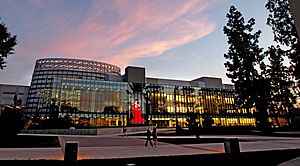
Colleges and Universities
California State University, Fresno is the main public university in Fresno. The University of California, Merced has a center in Fresno, and the University of California, San Francisco has a medical program here.
Private colleges include:
- Alliant International University
- California Christian College
- Fresno Pacific University
- Kaplan College, Fresno campus
- National University, Fresno campus
- University of Phoenix
- DeVry University
Community Colleges
Public community colleges in Fresno are Fresno City College and Clovis Community College.
Career Colleges
- Institute of Technology
- San Joaquin Valley College
- UEI College
Public K-12 Schools
Most of Fresno is part of the Fresno Unified School District. Some smaller parts are served by other school districts like Clovis Unified School District and Central Unified School District.
Private K-12 Schools
- Fresno Christian High School
- San Joaquin Memorial High School (Catholic)
- Fresno Adventist Academy
Media in Fresno
Newspapers
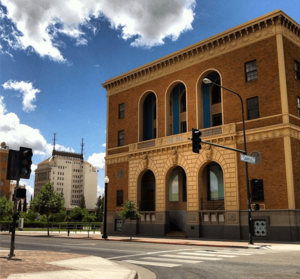
- The Business Journal
- The Fresno Bee
- The Community Alliance
Radio Stations
- KMJ, AM 580 and FM 105.9, was Fresno's first radio station, starting in 1922. Its strong signal can be heard across much of California.
- KYNO AM 940 plays oldies music.
- KFIG AM 1430 is an ESPN sports radio station.
- 88.1 KFCF is a non-commercial radio station.
- 89.3 KVPR provides National Public Radio (NPR) programs and classical music.
- 90.7 KFSR is another non-commercial station that plays a variety of music, including Jazz and Armenian music. It's based at the CSUF campus.
- 94.9 KBOS-FM is known as B95, Fresno's Hip-Hop Station.
Television Stations
Because of other TV stations nearby, Fresno was set up to have only UHF television stations. The first TV station in Fresno was KMJ-TV, which started broadcasting on June 1, 1953. It is now known as NBC affiliate KSEE. Other Fresno stations include:
- ABC affiliate KFSN-TV
- CBS affiliate KGPE
- The CW affiliate KFRE-TV
- FOX affiliate KMPH-TV
- MNTV affiliate KMSG-LD
- PBS station KVPT
- Telemundo station KNSO
- Univision station KFTV-DT
- Estrella TV affiliate KGMC
In 2012, the City of Fresno opened the Community Media Access Collaborative (CMAC), which is a public, education, and government access television station.
Infrastructure in Fresno
Since 2010, California has had many droughts. This has made it harder for Fresno and the Central Valley to get enough water. The city gets its water from Millerton Lake and Pine Flat Reservoir.
Transportation in Fresno
Highways
Fresno is served by State Route 99, which is the main highway running north and south through California's Central Valley. State Route 168 goes east to Clovis and Huntington Lake. State Route 41 (Yosemite Freeway) comes into Fresno from the south and then heads north to Yosemite National Park. State Route 180 (Kings Canyon Freeway) comes from the west and goes east through Reedley to Kings Canyon National Park.
Fresno is the largest U.S. city that isn't directly connected to an Interstate highway. When the Interstate Highway System was built in the 1950s, Interstate 5 was built on the west side of the Central Valley, bypassing many cities like Fresno. Because of the growing population and traffic on State Route 99, there's been talk about upgrading it to an interstate highway.
Bus Services
Fresno Area Express (FAX) is the city's main public bus system. It has 18 routes and a special service called Handy Ride for people with disabilities. In 2017, FAX started a frequent bus service called FAX15, with buses running every 15 minutes on Cedar and Shaw Avenues. In 2018, the FAX Q line was introduced, offering service every 10 minutes on Blackstone Avenue, Ventura Avenue, and Kings Canyon Road.
Fresno also has bus services from nearby areas, like Clovis Transit and Fresno County Rural Transit Agency. Long-distance bus services are provided by Greyhound. The Yosemite Area Regional Transportation System started a summer bus service between Fresno and Yosemite National Park in 2015.
Fresno used to have trolley service in the late 1800s and early 1900s. Horse-drawn streetcars ran from 1887 to 1901, and electric streetcars were used from 1903 to 1939.
Airports
Fresno Yosemite International Airport (FAT) offers regular flights. About 1.3 million passengers use this airport each year.
Fresno Chandler Executive Airport (FCH) is about 2 miles (3.2 km) southwest of Downtown Fresno. It was built in the 1920s and is one of California's oldest working airports. Today, it's used for general aviation (private planes).
Sierra Sky Park Airport (E79) in Northwest Fresno is a private airport open to the public. The streets around the airport are extra wide, so people living there can land their planes, taxi down the streets, and park them in their home garages. Sierra Sky Park is known as the first neighborhood in the world where people can park their planes at home.
Rail Services
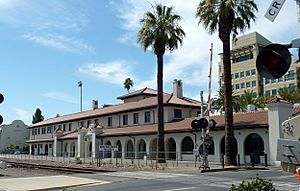
Passenger train service is provided by Amtrak's San Joaquins line. The main train station is the historic Santa Fe Railroad Depot in Downtown Fresno, which has been renovated. The city of Fresno is also planned to be a stop for the future California High-Speed Rail.
Freight train services are provided by both the BNSF Railway and the Union Pacific Railroad. Both companies have major rail lines and yards in Fresno.
Notable People from Fresno
Sister Cities of Fresno
Fresno has several sister cities around the world:
 Guadalajara, Mexico
Guadalajara, Mexico Kōchi, Japan (since 1965)
Kōchi, Japan (since 1965) Münster, Germany (since 1984)
Münster, Germany (since 1984) Morogoro, Tanzania (since 1992)
Morogoro, Tanzania (since 1992) Verona, Italy (friendship city since 2000)
Verona, Italy (friendship city since 2000) Vagharshapat (also known as Etchmiadzin), Armenia (since 2009)
Vagharshapat (also known as Etchmiadzin), Armenia (since 2009) Châteauroux, France (since 2016)
Châteauroux, France (since 2016) Taishan, China
Taishan, China Afula-Gilboa, Israel
Afula-Gilboa, Israel Taraz, Kazakhstan (currently inactive)
Taraz, Kazakhstan (currently inactive) Torreon, Mexico
Torreon, Mexico
Images for kids
-
The San Joaquin Light and Power Corporation Building, built in 1923
-
The Old Fresno Water Tower, built in 1894
-
The historic Tower Theatre for the Performing Arts, built in 1939
-
Bank of Italy Building, built in 1918
-
Exhibit at the Fresno Chaffee Zoo
-
Fresno State Library at California State University, Fresno
-
The historic Fresno Bee Building
-
Historic Santa Fe Station in Downtown Fresno
See also
 In Spanish: Fresno (California) para niños
In Spanish: Fresno (California) para niños


